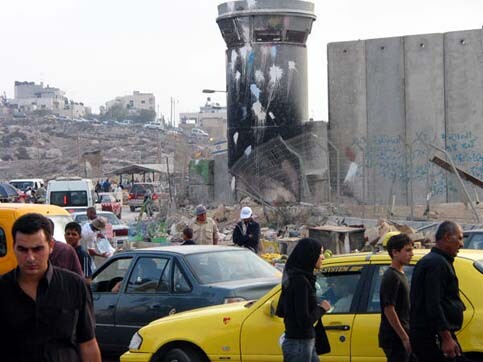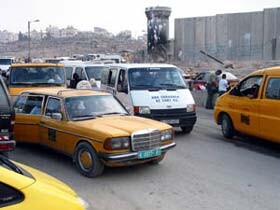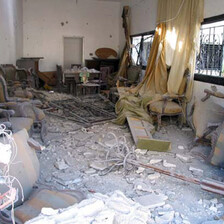Qalandia checkpoint, West Bank 15 November 2004

The apartheid wall, marked with Palestinian paint bombs, at the Qalandia checkpoint that separates Ramallah and Al-Quds (Jerusalem). (Samia A. Halaby)
I am thirsty, sitting here in the wrong corner of the ‘service’ (pronounced ‘serveece’) taxi. It is hot. The seat belt is tight, scratching my neck. I am sweating. The sun is beating down on me. I am hungry. My mind meanders, searching various avenues of escape. Could I walk through the checkpoint, leaving my fellow Palestinians behind? Would I find a car on the other side? Could I pay a sum to a private car waiting in line on the other side of the dead, closed closure point? Could I persuade someone to leave the line and turn around and take me to my destination?
A dog, female, thin, bony, teats shaped by puppies sucking at them, walks in the sun searching for food and water. She looks worse than I feel. I immediately begin to think of the wounds left by attacking dogs on the body of a boy who was shot by Israelis. I think those Israelis, emotionally and mentally twisted by the torture they apply and enjoy, who set their dogs to attack the boy they wounded. I remember the boy’s father telling us his story at Aida refugee camp and the boy showing his many scars — the boy refusing to be interviewed because the bullet they shot in his brain left damage.
It serves me right that at Qalandia I accidentally took the “service” without checking if it was going the road of the Arabs or the road of the ajaaneb (“foreigners”). I failed to check if the van had a white or a yellow license. Taking the road for Arabs means much more time and the added agony of another closure point. Then I think that lets me see more fully what it is like to be tortured like other Palestinians. I am angry with myself for making this mistake which teaches me how little I still know of what life is like here in the West Bank for Palestinians living under Israeli occupation and fascism.

Cars usually wait in a long queue to pass through the checkpoint, so the best option is often to take a “service” to the checkpoint, walk through, and then catch another “service” at the other end. (Samia A. Halaby)
A few days ago comming from the other end, a bus load of both Palestinians and foreigners, we were denied access through this closure point. The Palestinians had to get out and walk through on foot and wait for us foreigners who had to return and drive the Valley of Fire a second time, exit through another closure point, and meet our friends at the appointed location. Now these are no longer closure points but rather controlled gateways between various bantustans.
So now again I drive into another West Bank bantustan, again having gone through the hellish gateway applied by Israel and ride again through the Valley of Fire in order to reach Al Quds (Jerusalem), the city of my birth.
Samia A. Halaby (1936) was born in Jerusalem. In 1948 she was forced to leave Palestine. Via Beirut, her family emigrated to the United States. She has worked at American universities for years, ending at the Yale School of Art. Her art has been exhibited internationally, including the Guggenheim Museum, the Art Institute of Chicago and the Institute Du Monde Arab.
Related links:




